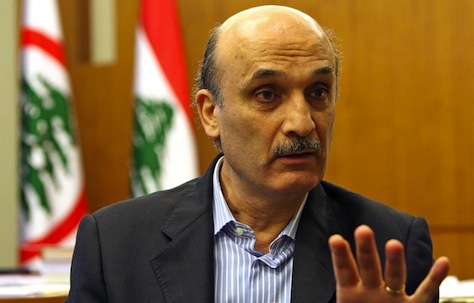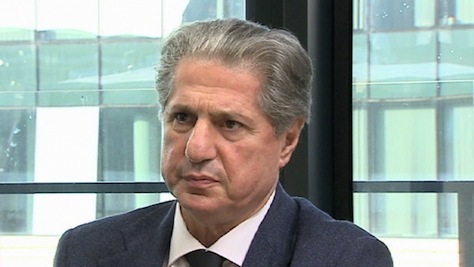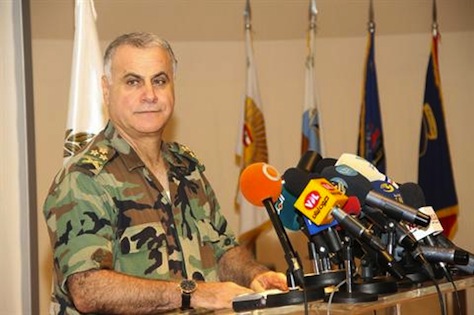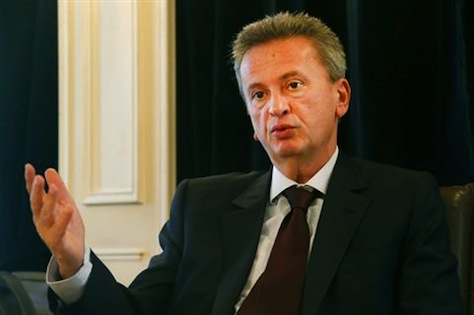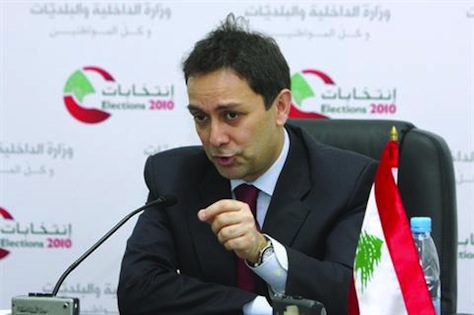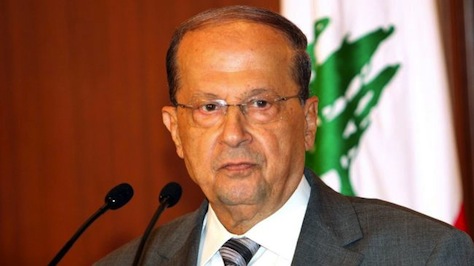 With the term of Lebanese president Michel Suleiman set to expire on May 25, the country’s 128-member parliament will convene tomorrow, April 23, for the first of what will likely be weeks of voting and negotiating to select a replacement.
With the term of Lebanese president Michel Suleiman set to expire on May 25, the country’s 128-member parliament will convene tomorrow, April 23, for the first of what will likely be weeks of voting and negotiating to select a replacement.![]()
Though the president has less day-to-day power over Lebanese governance, it’s a vital post at a time when national unity is stretched to its limits and Syria nears the third anniversary of the start of a brutal civil war that falls along precarious sectarian lines. Syria’s conflict has brought a massive wave of refugees into Lebanon, and it’s also caused significant unrest from Tripoli to Beirut, with some Shiite Lebanese intervening on behalf of the regime of Syrian president Bashar al-Assad and some Sunni Lebanese intervening on behalf of anti-Assad rebels.
Though Suleiman has only served as Lebanon’s president since 2007, his increasingly critical remarks against Hezbollah (حزب الله), the powerful social, political and military Shiite organization, have made it unlikely that he’ll win reelection. Hezbollah, among all of Lebanon’s political groups, has taken the boldest and most consequential steps into the Syrian war in support of Assad.
The presidential vote follows the successful formation of a new government in February, which itself followed ten months of difficult negotiations guided by Lebanon’s current prime minister Tammam Salam. The national unity government includes ministers from the ‘March 8’ bloc,* the ‘March 14’ bloc and top Druze leader Walid Jumblatt’s Progressive Socialist Party (الحزب التقدمي الاشتراكي), which has switched between the March 8 and March 14 camps throughout the past five years.
Under Lebanon’s complex confessional system, whereby 64 seats in Lebanon’s national assembly (مجلس النواب) are reserved each for Muslims and for Christians, the presidency traditionally goes to a Maronite Christian, the premiership to a Sunni Muslim and the speakership of the national assembly to a Shiite Muslim.
That means that the race will feature some of Lebanon’s most prominent Maronite leaders. But with a two-thirds majority required to win the presidency, no one believes that Lebanon will choose its next president anytime soon. (In the second round of voting, a candidate needs only a simple majority to win the presidency.)
Right now, the only major declared candidate is Samir Geagea (pictured above, top), the leader of the Lebanese Forces (القوات اللبنانية). For now, at least, Geagea is the candidate backed by the entire cross-confessional March 14 coalition. But Geagea isn’t the most uniting candidate, even within the March 14 camp. He’s unlikely to wield enough support, even in the second round, to win enough over votes from the March 8 coalition, which will likely cast blank ballots in tomorrow’s vote. The March 8 bloc’s top choice for the presidency will almost certainly be Michel Aoun (pictured above, bottom), the leader of the Free Patriotic Movement (التيار الوطني الحر), the most prominent Maronite group within the March 8 alliance.
As it stands, the first round is more important for establishing the relative strength of each bloc than for electing a president outright — to that degree, both Geagea and Aoun (to the extent casting a blank vote is casting a blank vote for Aoun) represent stalking horses for the March 14 and March 8 camps.
A Maronite rivalry forged in the 1980s
The Geagea-Aoun rivalry is perhaps one of the most infamous of the Lebanese civil war period, and they carry decades of political baggage — even within the Maronite community.
Geagea, from a northern mountain town, and Aoun, from a Beirut suburb, both rose to prominence during the 1980s, Geagea as the leader of the Lebanese Forces and Aoun more conventionally through the ranks of the Lebanese military. Even as their forces fought Lebanese Muslims, the Druze, Syrians and Palestinians, Geagea and Aoun spent much of the 1980s fighting each other for dominance over the Maronite forces.
Aoun emerged at the end of the civil war as the head of one of two competing governments in Lebanon, one a mostly Christian military government, the other a mostly Muslim civilian government. Aoun spent most of his time in power waging a war of liberation against the Syrian army (with the support of Iraq’s Saddam Hussein), though his government fell when the Syrian army toppled him in 1990 with tacit US support. Shortly thereafter, Aoun fled Lebanon for France, where he remained for the next 15 years.
Geagea’s future was even worse. Geagea continued to clash politically with the Syrian regime even after the civil war, and he was convicted of ordering the bombing of a church in 1994. Though it’s not at all clear that the Lebanese Forces had anything to do with the 1994 bombing, Geagea was imprisoned for the next 11 years for that and more plausible crimes committed during the civil war period.
Upon Aoun’s return to Lebanon in 2005, following the ‘Cedar revolution’ that led to the withdrawal of all Syrian troops from the country, he quickly became the most popular Maronite leader, and his Free Patriotic Movement won the largest bloc of Maronite support in the May-June 2005 parliamentary elections. Geagea, meanwhile, was also released from prison shortly thereafter, as anti-Syrian forces took power following the 2005 ‘Cedar revolution.’ With his release and a notable apology for the mistakes his militia committed during the civil war, Geagea soon also became an influential Maronite political leader.
Though Aoun was instrumental in building the current unity government, and though (or maybe because) he’s never completely won the trust of the largest Shiite group in the March 8 coalition, Hezbollah, he probably stands a greater chance of winning the presidency than Geagea.
All signs point to a compromise candidate for the presidency
While the first round will largely focus on Geagea and Aoun, they don’t represent the universe of potential compromise candidates that could emerge in the second or subsequent rounds of voting when the threshold for election lowers from two-thirds to a simple majority.
Jumblatt, for what it’s worth, has nominated Henry Helou, a minor MP, though Jumblatt’s bloc could ultimately tip the balance one way or another — Jumblatt’s decision to leave from the March 14 bloc in 2011 brought the March 8 bloc to power.
At the top of the list is Amine Gemayel (pictured above), who served as Lebanon’s president between 1982 and 1988, and leads another Maronite party, the Kataeb Party (or Phalange, حزب الكتائب اللبنانية). As a former president during the most difficult time in Lebanon’s civil war, Gemayel has some credibility among both sides for trying to hold the country together, but he’s also seen as anathema for working too closely with Israel during his presidency. Though the March 14 bloc may unite behind Geagea in the first round, Gemayel seems likely to launch his own bid shortly after the initially vote.
Since the end of the civil war, Lebanon’s army has earned a reputation for strict impartiality, and it is still one of the few national institutions that all Lebanese citizens respect, although that’s been sorely tested over the past three years as Syrian violence has spilled over into Lebanon. It’s one of the reasons that Lebanon’s two presidents since 1998, Suleiman and Émile Lahoud, both served as former commanders of the Lebanese army. That means that the current army commander, Jean Kahwagi (pictured above), could also emerge as a consensus candidate, though he’s still a somewhat more controversial choice that Lahoud in 1998 or Suleiman in 2007 because of the more hands-on role that the Lebanese army has taken against Syria-related violence.
Among the other most discussed compromise candidates is Riad Salameh (pictured above), the longtime president of the Banque du Liban (مصرف لبنان), the country’s central bank. He’s guided monetary policy since 1993, and he’s won significant praise for steering Lebanon’s economy fairly successfully through the post-war reconstruction, the 2005 tumult, the 2006 war with Israel, and now through the Syrian civil war. Though the central bank hardly has the same powerful unifying role as the Lebanese army, Salameh perhaps comes closest to the Lahoud-Suleiman ideal than even Kahwagi.
Perhaps the most tantalizing consensus candidate is Ziad Baroud, who at age 43 is the rising star of Lebanese politics — born in 1970, he was far too young to lead a militia during the civil war or bear any of its scars, unlike Gemayel, Geagea, Aoun and the rest. He served as minister of interior and municipalities in two ‘March 14’ governments between 2008 and 2011, though he has relatively good working relationships within the March 8 camp as well. His reputation is a good-government technocrat, and he’s currently one of the most popular Lebanese politicians of any sect or religion. The patriarch of the Maronite Church, Bechara Boutros al-Rahi, who may wield significant influence on the presidential choice, is reported to favor a consensus candidate, and he’s praised Baroud heartily in the past for putting Lebanon’s national well-being above politics.
* * * * *
* For those of you uninitiated to the complexities of Lebanon’s competing political blocs, here’s a rough guide, adapted from a prior post on Lebanon from 2012:
Syrian troops first came to Lebanon during its civil war from the late 1970s through the early 1990. Syria continued to play a special role in directing the policy of Lebanon’s government well after the end of hostilities, and it wasn’t unusual for the Assad regime to take a direct role in Lebanese politics. In February 2005, Lebanon’s former prime minister Rafik Hariri was assassinated — the killing occurred with either Syrian acquiescence or, at worst, at the direction of Syrian forces. The subsequent ‘Cedar revolution’ forced the withdrawal of Syrian troops from Lebanon, although Assad’s regime continued to play a role in Lebanese politics up through the beginning of Syria’s own civil war in 2011.
Today, the two major blocs in Lebanese politics derive from the 2005 upheavals — the pro-Syrian ‘March 8’ bloc, and the anti-Syrian ‘March 14’ bloc, each named for the day of a respective demonstration for and against Syria. That’s now somewhat outdated, because the key Maronites in the March 8 bloc were never particularly pro-Syria, and Sunni Lebanese within the March 8 bloc today have no particular love for Assad.
The March 14 bloc includes most of Lebanon’s Maronite parties, which in turn spring largely from Maronite militias from the civil war period: Gemayel’s Kataeb Party, Geagea’s Lebanese Forces, and the National Liberal Party (حزب الوطنيين الأحرار), which is led by Dory Chamoun, son of a former Lebanese president in the 1950s.
It also includes the largest Sunni group in Lebanon, the Future Movement (Arabic: تيار المستقبل, (Arabic: تيار المستقبل), which is led by Saad Hariri, the son of the assassinated Rafik Hariri, and prime minister in his own right between 2009 and 2011.
The March 8 coalition includes all of Lebanon’s major Shiite groups, including Hezbollah and Amal (حركة أمل), which is led by longtime parliamentary speaker Nabih Berri. It also includes the followers of the Tripoli-based former prime minister Najib Mikati, who served between 2011 and 2013, Aoun’s Free Patriotic Movement and most of Lebanon’s Greek Orthodox politicians, including the Syrian Social Nationalist Party (الحزب السوري القومي الاجتماعي).
